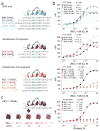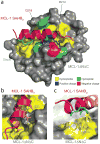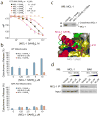The MCL-1 BH3 helix is an exclusive MCL-1 inhibitor and apoptosis sensitizer
- PMID: 20562877
- PMCID: PMC3033224
- DOI: 10.1038/nchembio.391
The MCL-1 BH3 helix is an exclusive MCL-1 inhibitor and apoptosis sensitizer
Abstract
The development of selective inhibitors for discrete anti-apoptotic BCL-2 family proteins implicated in pathologic cell survival remains a formidable but pressing challenge. Such precisely tailored compounds would serve as molecular probes and targeted therapies to study and treat human diseases driven by specific anti-apoptotic blockades. In particular, MCL-1 has emerged as a major resistance factor in human cancer. By screening a library of stabilized alpha-helix of BCL-2 domains (SAHBs), we determined that the MCL-1 BH3 helix is itself a potent and exclusive MCL-1 inhibitor. X-ray crystallography and mutagenesis studies defined key binding and specificity determinants, including the capacity to harness the hydrocarbon staple to optimize affinity while preserving selectivity. MCL-1 SAHB directly targets MCL-1, neutralizes its inhibitory interaction with pro-apoptotic BAK and sensitizes cancer cells to caspase-dependent apoptosis. By leveraging nature's solution to ligand selectivity, we generated an MCL-1-specific agent that defines the structural and functional features of targeted MCL-1 inhibition.
Figures





Comment in
-
Stapled peptides: Magic bullets in nature's arsenal.Nat Chem Biol. 2010 Aug;6(8):566-7. doi: 10.1038/nchembio.407. Nat Chem Biol. 2010. PMID: 20644540 No abstract available.
Similar articles
-
The BH3 alpha-helical mimic BH3-M6 disrupts Bcl-X(L), Bcl-2, and MCL-1 protein-protein interactions with Bax, Bak, Bad, or Bim and induces apoptosis in a Bax- and Bim-dependent manner.J Biol Chem. 2011 Mar 18;286(11):9382-92. doi: 10.1074/jbc.M110.203638. Epub 2010 Dec 9. J Biol Chem. 2011. PMID: 21148306 Free PMC article.
-
Specific cleavage of Mcl-1 by caspase-3 in tumor necrosis factor-related apoptosis-inducing ligand (TRAIL)-induced apoptosis in Jurkat leukemia T cells.J Biol Chem. 2005 Mar 18;280(11):10491-500. doi: 10.1074/jbc.M412819200. Epub 2005 Jan 6. J Biol Chem. 2005. PMID: 15637055
-
Mcl-1 interacts with truncated Bid and inhibits its induction of cytochrome c release and its role in receptor-mediated apoptosis.J Biol Chem. 2006 Mar 3;281(9):5750-9. doi: 10.1074/jbc.M505688200. Epub 2005 Dec 27. J Biol Chem. 2006. PMID: 16380381
-
Molecular analysis of functional redundancy among anti-apoptotic Bcl-2 proteins and its role in cancer cell survival.Exp Cell Res. 2014 Apr 1;322(2):415-24. doi: 10.1016/j.yexcr.2014.02.010. Epub 2014 Feb 17. Exp Cell Res. 2014. PMID: 24556425 Free PMC article.
-
Solution structure of prosurvival Mcl-1 and characterization of its binding by proapoptotic BH3-only ligands.J Biol Chem. 2005 Feb 11;280(6):4738-44. doi: 10.1074/jbc.M411434200. Epub 2004 Nov 18. J Biol Chem. 2005. PMID: 15550399
Cited by
-
Mechanisms of action of Bcl-2 family proteins.Cold Spring Harb Perspect Biol. 2013 Apr 1;5(4):a008714. doi: 10.1101/cshperspect.a008714. Cold Spring Harb Perspect Biol. 2013. PMID: 23545417 Free PMC article. Review.
-
HTS by NMR of combinatorial libraries: a fragment-based approach to ligand discovery.Chem Biol. 2013 Jan 24;20(1):19-33. doi: 10.1016/j.chembiol.2012.10.015. Chem Biol. 2013. PMID: 23352136 Free PMC article.
-
Decoding and unlocking the BCL-2 dependency of cancer cells.Nat Rev Cancer. 2013 Jul;13(7):455-65. doi: 10.1038/nrc3538. Epub 2013 Jun 20. Nat Rev Cancer. 2013. PMID: 23783119 Review.
-
ψ-Bufarenogin, a novel anti-tumor compound, suppresses liver cancer growth by inhibiting receptor tyrosine kinase-mediated signaling.Oncotarget. 2015 May 10;6(13):11627-39. doi: 10.18632/oncotarget.3435. Oncotarget. 2015. PMID: 25890498 Free PMC article.
-
Getting in shape: controlling peptide bioactivity and bioavailability using conformational constraints.ACS Chem Biol. 2013 Mar 15;8(3):488-499. doi: 10.1021/cb300515u. Epub 2012 Nov 30. ACS Chem Biol. 2013. PMID: 23170954 Free PMC article. Review.
References
-
- Tsujimoto Y, Cossman J, Jaffe E, Croce CM. Involvement of the bcl-2 gene in human follicular lymphoma. Science. 1985;228:1440–3. - PubMed
-
- Danial NN, Korsmeyer SJ. Cell death: critical control points. Cell. 2004;116:205–19. - PubMed
-
- Sattler M, et al. Structure of Bcl-xL-Bak peptide complex: recognition between regulators of apoptosis. Science. 1997;275:983–6. - PubMed
-
- Muchmore SW, et al. X-ray and NMR structure of human Bcl-xL, an inhibitor of programmed cell death. Nature. 1996;381:335–41. - PubMed
-
- Chen L, et al. Differential targeting of prosurvival Bcl-2 proteins by their BH3-only ligands allows complementary apoptotic function. Mol Cell. 2005;17:393–403. - PubMed
Publication types
MeSH terms
Substances
Grants and funding
LinkOut - more resources
Full Text Sources
Other Literature Sources
Molecular Biology Databases

